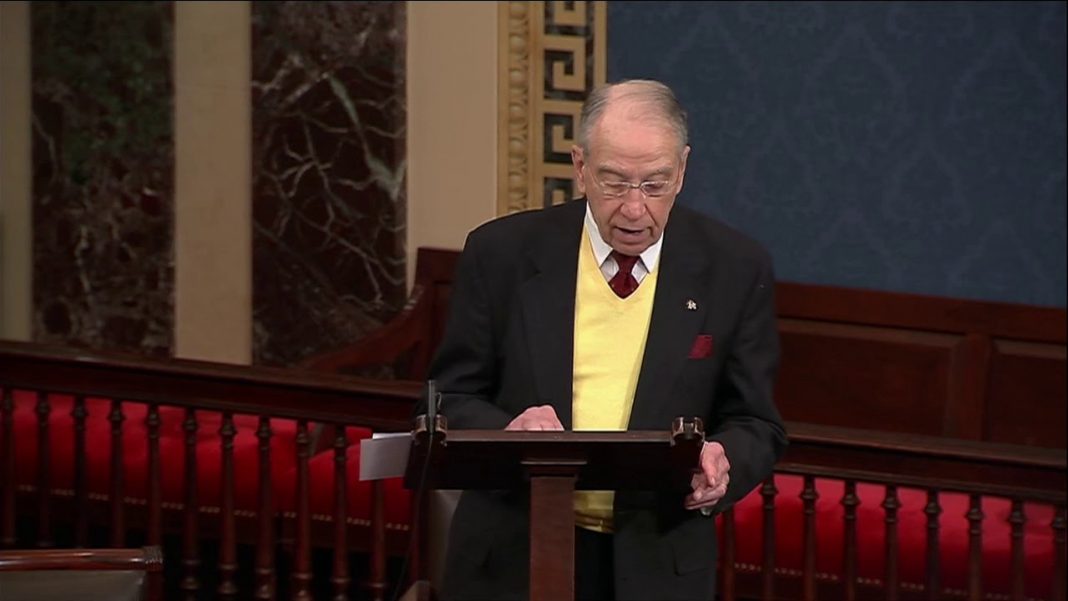Mr. President,
I appreciate Senator Ernst for organizing this opportunity to discuss the Green New Deal this week.
To put it mildly the Green New Deal is ambitious. To frame it more accurately, it is an unworkable pie-in-the-sky attempt to reshape every aspect of everyday Americans’ lives.
First, let me say that I am proud of my record in successfully advancing the availability and affordability of renewable energy.
Many have called me the “father” of the Wind Energy Incentives Act of 1992.
My legislation sought to give this alternative energy source the ability to compete against traditional, finite energy sources.
And it has been extremely successful.
Now, Iowa supplies more than 35 percent of its own electricity from wind energy.
We were the first state in the country to generate more than one-third of its electricity from wind.
Wind energy employs approximately 7,000 Iowans and the nearly 3,000 wind turbines in Iowa generate millions of dollars in economic activity.
So I want to make it clear that I’m speaking as someone with a successful track record of advancing clean energy.
The Green New Deal, on the other hand, is nothing more than a grab bag of vague aspirations. In fact, the Green New Deal was initially introduced in the House and Senate by the authors as a non-binding, symbolic resolution.
That means that even if passed as introduced, it could not become law.
I’m glad that Senate Majority Leader McConnell re-introduced the text in a format that could become law so senators can go on record as to whether they want to make this the policy of the United States.
It would be one thing if the policies and goals remained on topic.
Namely reducing pollution and cutting our nation’s carbon emissions.
But the resolution reads like a utopian manifesto seeking to implement every liberal policy priority from the past many decades.
We’ve seen how extreme left wing agendas that rely on the power of the state and usurp the role of the individual turn out.
From the Soviet Union to Cuba to Venezuela, it never turns out well.
Sure, the Green New Deal includes goals related to energy and the environment, but for the most part they are wholly unrealistic.
For example, calling for “upgrading all existing buildings” or “meeting 100 percent of the power demand in the United States through clean, renewable, and zero-emission energy sources,” all within the next ten years, is simply not feasible.
And, of course, no concrete proposals are put forward on how this is to be achieved.
It just leaves us scratching our heads thinking about how all this would work.
Would it require the government to mandate that every building owner in the United States make costly building improvements to meet national standards set from Washington, D.C.?
Would every homeowner have to submit to government inspection to ensure his or her home meets the standards dictated by the state?
What government expenditures would have to be made, assuming it is even technologically possible, to go from about 17 percent of the U.S. electricity generation coming from renewables today to 100 percent in 10 years?
Are backers of the Green New Deal willing to support nuclear energy as a means to reach their goal?
A summary of the Green New Deal initially put out by the chief author in the House suggests not.
As I said, I have been a leader on renewable energy production for decades.
Again, I was the original author of the wind energy production tax credit in 1992.
During my leadership of the Senate Finance Committee in the 2000s, I oversaw the establishment, enhancement, and renewal of numerous tax incentives that promote everything from wind and solar, to renewable fuels like biodiesel, to energy efficient buildings, homes and appliances.
Unlike the unrealistic goals of the Green New Deal, these are real, proven, bipartisan actions I shepherded into law to make the United States more energy independent and improve our environment.
Unfortunately, many of these key energy incentives I just mentioned are currently expired and have been for over a year.
We had a real opportunity to extend these energy incentives as part of the appropriations deal reached earlier this month.
But that was ultimately blocked by House Democrats.
They seem overly focused on lofty goals of the Green New Deal, or as Speaker Pelosi called it “the green dream or whatever they call it, nobody knows what it is…”
They could not be bothered with extensions of existing and successful provisions that incentivize the type of investments they claim to back. Provisions that support millions of jobs for people who are actually “willing to work.”
Perhaps this just shows that the Green New Deal is less about tackling energy and environmental issues and more about remaking America into a dreamy new progressive paradise.
No sector of the economy is left untouched by the Green New Deal. Make no mistake.
The authors are intent on reshaping every aspect of American life through a “national, social, industrial, and economic mobilization” that is eerily reminiscent of the five year plans of the former Soviet Union or the “Great Leap Forward” under Chairman Mao of China.
Even the family farmer is not spared from its grand plans.
The Green New Dealers want to remove “pollution and greenhouse gas emissions” in the agriculture sector through “sustainable farming” and “building a more sustainable food system that ensures universal access to healthy food.”
Now, I’m not against farmers taking actions to prevent soil erosion and minimize pollution.
This is something farmers have been doing for decades.
The recently-passed farm bill invests more in conservation programs than ever before.
I trust that farmers know more, and have more sense, about how to take care of their land than some bureaucrat in Washington, DC or politician from New York City.
Over the last several years, we’ve seen farmers readily adopt the use of cover crops to help prevent nutrient runoff and sequester carbon in the soil.
Today’s farmers may go down as the first group in history to leave the land better than they found it for future generations.
Moreover, every indication is that these calls for “sustainable farming” and a “sustainable food system” go well beyond farmers being good stewards of our natural resources.
It appears to be intent on changing everything from how we farm to what we farm.
A fact sheet released by the House author shortly after introduction made this perfectly clear.
It notes a desire to rid the planet of methane-gas-emitting cows.
In case the authors are unaware, all cows, and all people, emit methane.
It’s part of the natural digestive process.
The only way to stop these “emissions” is to ban animal agriculture.
That proposal couldn’t be more disconnected or out of touch with Americans.
But don’t worry.
According to the author of the Green New Deal in the House, “it’s not to say you get rid of agriculture” or “force everybody to go vegan.”
This doesn’t instill much confidence in this farmer about the real intentions of the Green New Deal.
I’m amazed by the scope of what the authors would have the government impose on the American people.
I will end by noting that I’m interested in working with my colleagues on sensible policies to secure our energy independence and improve the environment.
But I fear this will not be possible so long as my Democratic colleagues remain intent on handing over the country to the government to remake in Washington, D.C.’s image.
I yield the floor.
















